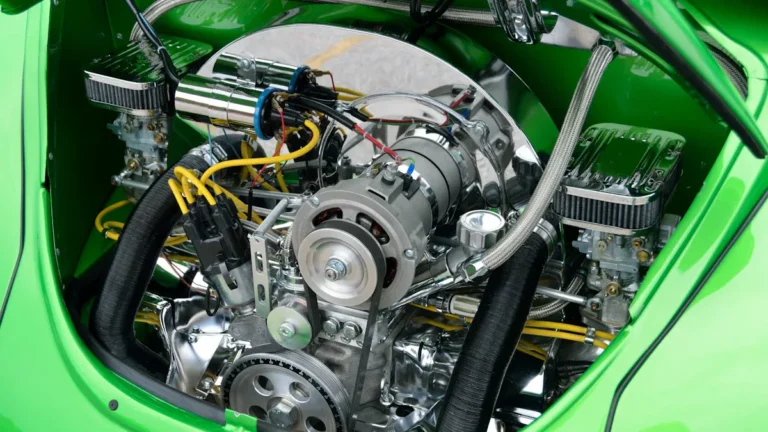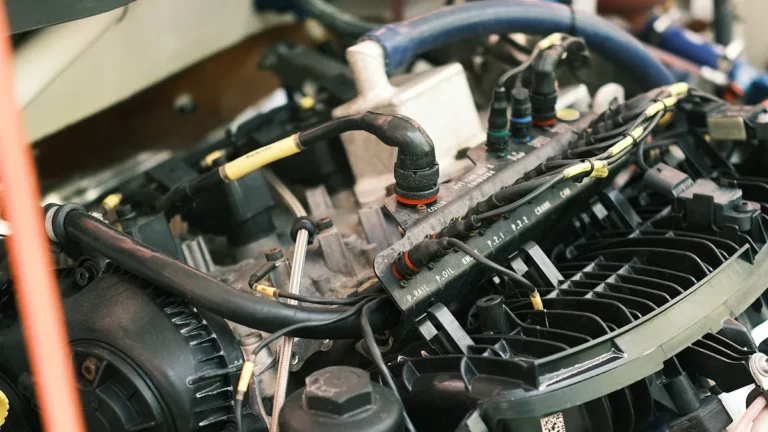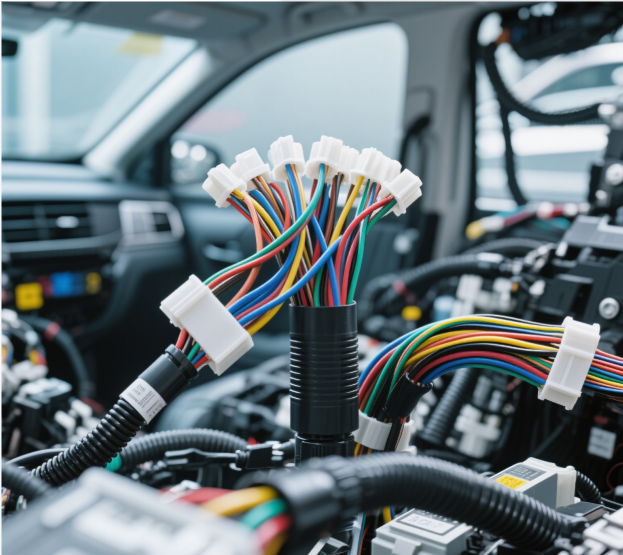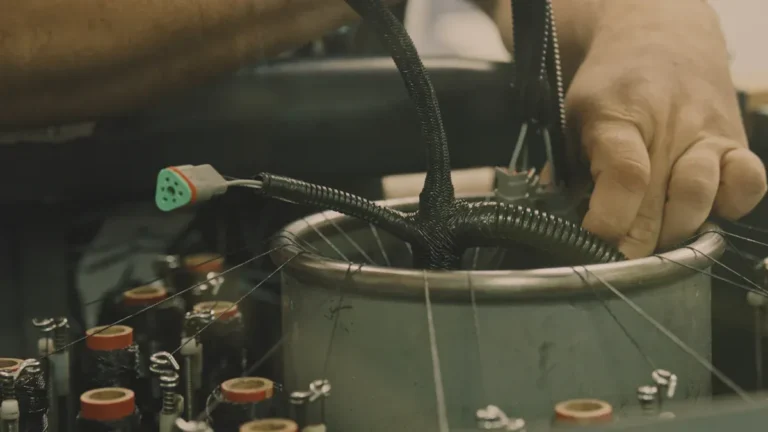Was ist ein Kabelbaum eines Autos und warum es wichtig ist? 2025

Ein Kabelbaum eines Autos ist eine Sammlung von Drähten, Anschlüsse, und Schutzhüllen, die verschiedene elektrische Komponenten in Ihrem Fahrzeug verbinden. Betrachten Sie es als das Nervensystem Ihres Autos, Übertragung von Strom und Daten, um einen nahtlosen Betrieb zu gewährleisten. Moderne Fahrzeuge verlassen sich auf diese Gurte, um fortschrittliche Funktionen wie Sensoren zu unterstützen, Sicherheitssysteme, und Konnektivität.
Der Der Markt für Kabelgurt des Automobils hat sich erheblich weiterentwickelt, Angetrieben von elektrischen und autonomen Fahrzeugen. Was einst mit den grundlegenden Funktionen übernommen hat, verwaltet jetzt komplizierte Netzwerke von Sensoren und Steuereinheiten, Präsentation seiner kritischen Rolle in den heutigen Fahrzeugen.
Key Takeaways
Ein Autokabelbaum verbindet elektrische Teile, Wie die Nerven eines Autos. Es hilft wichtigen Systemen, Wie Lenkung und Bremsen, gut arbeiten.
Neue Kabelbäume sind der Schlüssel für moderne Automerkmale. Sie unterstützen Sicherheitswerkzeuge wie Airbags und Technik wie Bluetooth und GPS.
Elektrische und selbstfahrende Autos benötigen spezielle Kabeldesigns. Diese Gurte tragen starke Leistung und senden viele Daten.
Gute Kabelbäume zu machen, ist sehr wichtig. Sorgfältige Tests stellt sicher, dass sie dauern und sicher bleiben, Probleme vermeiden.
Wie die Technologie wächst, Kabelbäume werden sich mit intelligenten Systemen verbinden. Dies verbessert Autofunktionen wie Fernprüfungen und intelligente Gespräche.
Was ist ein Kabelbaum eines Autos verdrahtet??
Definition und Zweck
Ein Kabelbaum eines Autos ist ein System organisierter elektrischer Kabel Entwickelt, um verschiedene Komponenten in Ihrem Fahrzeug zu verbinden und mit Strom zu versorgen. Es fungiert als Rückgrat für Energie- und Informationsfluss, Sicherstellen, dass wesentliche Funktionen wie Lenkung, Bremsen, und die Beleuchtung reibungslos funktionieren. Über diese Grundlagen hinaus, Es unterstützt auch sekundäre Merkmale wie Klimaanlage, Infotainmentsysteme, und sogar fortschrittliche Sicherheitstechnologien.
Betrachten Sie es als das Kreislaufsystem Ihres Autos, Strom und Signale an jede Ecke liefern. Ohne es, Moderne Fahrzeuge würden Schwierigkeiten haben, effizient zu funktionieren.
Die zunehmende Komplexität der Automobilelektronik hat Kabelbäume unverzichtbar gemacht. Sie halten Drähte organisiert, Reduzieren Sie das Risiko elektrischer Fehler, und vereinfachen Sie die Fahrzeugbaugruppe.
Wie es in einem Fahrzeug funktioniert
Ein Kabelbaum eines Autos arbeitet durch Übertragung von Strom und Signalen zwischen den Komponenten. Zum Beispiel, Es verbindet Sensoren mit elektronischen Steuereinheiten (ABDECKUNG), Aktivieren Sie die Echtzeit-Datenverarbeitung für Systeme wie Airbags und Anti-Lock-Bremsen.
Der Herstellungsprozess umfasst mehrere Schritte:
Kabelumwandlung: Drähte werden mit speziellen Maschinen geformt und hergestellt.
Verdrehen und Schweißen: Einige Drähte werden für eine bessere Konnektivität verdreht, während andere für die Haltbarkeit verschweißt werden.
Montage und Test: Alle Komponenten werden miteinander verbunden, auf Funktionalität getestet, und werden Qualitätskontrollen unterzogen.
Verfahren | Beschreibung |
|---|---|
Kabelumwandlung | Erste Transformationen von Kabeln in CCS -Maschinen. |
Verdrehungsmaschine | Einige Drähte werden für eine bessere Konnektivität verdreht. |
Schweißmaschine | Andere Kabel werden durch Schweißen verarbeitet. |
Zwischenspeicher | Kabel, die in früheren Prozessen nicht verwendet werden, werden vorübergehend gespeichert. |
Montageprozess | Alle Teile werden miteinander verbunden, um den Kabelbaum zu bilden. |
Elektrische Tests | Das fertige Produkt wird auf korrekte Funktionen getestet. |
Qualitätskontrolle | Endgültige Qualitätskontrollen und Verpackung der Kabelbäume. |
Dieser komplizierte Prozess stellt sicher, dass der Kabelbaum die Anforderungen moderner Fahrzeuge erfüllen kann, Von der Antriebsscheinwerfern bis hin zur Aktivierung intelligenter Funktionen.
Unterschiede zu herkömmlichen Kabelsystemen
Die Kabelbäume der Autos unterscheiden sich erheblich von herkömmlichen Kabelsystemen. Ältere Systeme waren einfacher, mit weniger Drähten und grundlegenden Funktionen. Moderne Gurte, Jedoch, sind weitaus komplexer und integrierter.
Aspekt | Automobilkabelbaum | Traditionelle Kabelsysteme |
|---|---|---|
Komplexität | Übersteigt die Komplexität der gesamten Autoverkabelung von 30 vor Jahren | Einfacher, Weniger integrierte Kabelsysteme |
Entwurfsprozess | Benötigt spezielle Designsoftware und detaillierte Schaltpläne | Grundlegende Kabel ohne erweiterte Designwerkzeuge |
Herstellung | Muss als separate Komponenten hergestellt werden, früh in der Versammlung hinzugefügt | Typischerweise in den Fahrzeugrahmen integriert |
Elektronische Steuermodule | Entwickelt für mehrere ECMs, die verschiedene Funktionen steuern | Weniger oder gar keine ECMs, einfachere Kontrollmechanismen |
Moderne Gurte unterstützen Funktionen wie Konnektivität, Autonomes Fahren, und Elektrofahrzeugsysteme, sie für die heutigen Autos wesentlich machen.
Bestandteile eines Autokabelbaums

Kabel und Kabel
Drähte und Kabel bilden die Grundlage eines Kabelbaums für Autoverdrahtung. Sie übertragen elektrische Leistung und Signale zwischen verschiedenen Komponenten, Sicherstellen, dass Ihr Fahrzeug reibungslos funktioniert. Diese Drähte sind so konzipiert, dass sie heftigen Bedingungen standhalten, einschließlich hoher Temperaturen, Luftfeuchtigkeit, und Exposition gegenüber Chemikalien. Hersteller testen sie streng auf Haltbarkeit, elektrische Leistung, und Umweltwiderstand.
Qualitätssicherungsprozesse umfassen mechanische Tests, elektrische Tests, und Inspektionen Für Temperatur- und Vibrationswiderstand. Dies stellt sicher, dass Kabel die Anforderungen moderner Fahrzeuge erfüllen können, insbesondere solche mit fortschrittlichen Funktionen wie autonomem Fahren.
Kabelbäume werden so angepasst, dass bestimmte Fahrzeugkonstruktionen angemessen sind, Raum optimieren und Gewicht reduzieren. Fehler in diesem System können zu Sicherheitsrisiken führen, Herstellung Qualitätskontrolle während der Produktion kritisch.
Anschlüsse und Terminals
Anschlüsse und Terminals spielen eine wichtige Rolle bei der Verknüpfung von Drähten mit elektrischen Komponenten. Anschlüsse gewährleisten sichere und zuverlässige Verbindungen, während die Terminals die Leitfähigkeit an den Enden von Drähten verbessern. Diese Komponenten werden aus hergestellt Hochleistungsmaterialien, die Verschleiß- und Umweltgefahren widerstehen.
Komponente | Bedeutung |
|---|---|
Leiter | Gewährleistet eine effiziente und ununterbrochene Übertragung von elektrischen Signalen. |
Anschlüsse | Bietet sichere und zuverlässige Verbindungen, Gewährleistung der ordnungsgemäßen Funktion des Geräts. |
Terminals | Verbessert die Zuverlässigkeit von Verbindungen und sorgt für eine konsequente elektrische Leitfähigkeit. |
Schutzhülsen | Erhöht die Lebensdauer des Geschirrs und sorgt für seine Funktionalität unter verschiedenen Bedingungen. |
Ferrulen | Bietet eine sichere Verbindung und verhindert, dass Drahtstränge ausfransen oder brechen. |
Halten Sie sich an Branchenstandards wie IPC/WHMA-AA-620 stellt sicher. Dies garantiert die Haltbarkeit, Sicherheit, und Zuverlässigkeit in Ihrem Kabelbaum Ihres Autos.
Schutzhüllen und Isolierung
Schutzhüllen und Isolierung schützen den Kabelbaum vor externen Schäden. Materialien wie Glasfaserhülsen und Silikonkautschuk bieten eine starke Zugfestigkeit und -beständigkeit gegen das Brechen. Diese Materialien entsprechen Umweltzertifizierungen wie EU ROHS2.0 und REACH, Sicherstellen, dass sie sicher und umweltfreundlich sind.
Glasfaserscheißen sind rauchfrei, halogenfrei, und ungiftig, sie ideal für Automobilanwendungen machen. Silikonkautschuk verbessert die Sicherheitsleistung und die Flexibilität unter extremen Bedingungen beibehalten.
Diese Schutzschichten verlängern die Lebensdauer des Kabelbaums und stellen sicher, dass sie in verschiedenen Umgebungen zuverlässig funktioniert. Sie werden häufig in Kabelbäumen der Automobilverkabelungen eingesetzt, Elektronik, und Elektrogeräte.
Wichtigkeit von Autoskabelbäumen in modernen Fahrzeugen
Leistungsverteilung und Signalübertragung
Ein Kabelbaum eines Autos spielt eine wichtige Rolle bei der Verteilung von Strom und Übertragung von Signalen in Ihrem Fahrzeug. Es stellt sicher, dass jede elektrische Komponente, Von Scheinwerfern bis hin zu Infotainment -Systemen, Empfängt die Energie und Daten, die sie benötigt, um zu funktionieren. Ohne dieses organisierte Netzwerk, Die Elektronik Ihres Fahrzeugs würde nicht effizient arbeiten.
Moderne Fahrzeuge verlassen sich auf Kabelbäume, um zunehmend komplexe elektrische Systeme zu behandeln. Zum Beispiel:
Elektrofahrzeuge (Evs) Erfordern Sie fortgeschrittene Kabelbäume, um ihre komplizierten Antriebsstrangsysteme zu unterstützen.
Fahrerassistanztechnologien, wie Spurwahrnehmung und adaptive Geschwindigkeitsregelung, Abhängig von der präzisen Signalübertragung, die durch Verkabelungsgurten aktiviert ist.
Die staatlichen Vorschriften zur Reduzierung der Emissionen haben die Hersteller dazu gedrängt, effiziente elektrische Systeme einzusetzen, Erhöhung der Bedeutung von Kabelbäumen erhöhen.
Durch Gewährleistung des nahtlosen Stromflusses und der Kommunikation, Verkabelungsgurten verbessern die Leistung und Zuverlässigkeit Ihres Fahrzeugs.
Rolle in Sicherheitssystemen (Z.B., Airbags, ABS)
Sicherheitssysteme wie Airbags und Anti-Lock-Bremssysteme (ABS) Verlassen Sie sich stark auf Kabelbäume, um korrekt zu funktionieren. Diese Gurte verbinden Sensoren, Steuereinheiten, und Bereitstellungsmechanismen, Ermöglichen Sie eine schnelle Kommunikation in Notfällen.
In Airbag -Systemen, Verkabelungsgurte sorgen für eine zeitnahe Bereitstellung, indem Signale von Absturzsensoren an die Steuereinheit übertragen werden. Diese schnelle Reaktion kann Leben bei Unfällen retten. Ähnlich, ABS -Systeme verwenden Kabelbäume, um Raddrehzahlsensoren mit der Steuereinheit zu verleihen. Diese Verbindung ermöglicht es dem System, während des plötzlichen Brems eine Radsperrung zu verhindern, Verbesserung der Stabilität Ihres Fahrzeugs.
Elektronische Stabilitätskontrolle (Esc) Systeme hängen auch von Kabelbäumen ab. Sie erleichtern die Datenübertragung zwischen Sensoren und ESC -Steuereinheit, Genauige Anpassungen an Bremskraft auf einzelnen Räder ermöglichen. Dies hilft dabei.
Qualitätskabelbäume verhindern elektrische Fehler, die diese kritischen Sicherheitssysteme beeinträchtigen könnten, Wenn Sie sicherstellen, dass Ihr Fahrzeug unter allen Bedingungen sicher ist.
Aktivität von Konnektivität und intelligenten Funktionen ermöglichen
Moderne Fahrzeuge werden schlauerer, und Verkabelungsgurten stehen im Mittelpunkt dieser Transformation. Sie ermöglichen Konnektivitätsfunktionen wie Bluetooth, W-lan, und GPS, die Ihr Fahrerlebnis verbessern.
Kabelbäume unterstützen auch fortschrittliche Infotainmentsysteme, Ermöglichen Sie, dass Sie auf Navigation zugreifen können, Musik, und Kommunikationstools nahtlos. In autonomen Fahrzeugen, Sie verbinden Sensoren und Steuereinheiten, Aktivieren Sie die Echtzeit-Datenverarbeitung für selbstfahrende Funktionen.
Der Aufstieg des Internets der Dinge (IoT) hat die Bedeutung von Kabelbäumen weiter erhöht. Sie integrieren intelligente Systeme, wie Ferndiagnostik und Fahrzeug-zu-Fahrzeug-Kommunikation, in dein Auto. Diese Konnektivität verbessert die Sicherheit, Effizienz, und Bequemlichkeit.
Wenn Fahrzeuge besser angeschlossen werden, Kabelbäume werden sich weiterentwickeln, Unterstützung der nächsten Generation der Automobiltechnologie.
Technologie in 2025 und seine Auswirkungen auf die Kabelbäume bei Autos

Elektrofahrzeuge und Verkabelungsdesign
Elektrofahrzeuge (Evs) verändern die Art und Weise, wie Verkabelungsgurte entworfen werden. Diese Fahrzeuge benötigen fortschrittliche Systeme, um die Hochspannungsstromverteilung und ein effizientes Energiemanagement zu bewältigen. Zum Beispiel, 800V Verkabelungen werden zu Standards, um schnelle Aufladungsfunktionen zu unterstützen. Diese Innovation reduziert die Ladezeiten und verbessert die Gesamtvehikelleistung.
Sie werden auch modulare Kabelsysteme in EVs der nächsten Generation bemerken. Mit diesen Designs können Hersteller Gurte für verschiedene Modelle anpassen, Verbesserung der Effizienz und Reduzierung der Kosten. Festkörperbatterien, Ein wesentlicher Fortschritt in der EV -Technologie, Erfordern Sie neue Thermal- und Spannungsmanagementlösungen. Kabelbäume müssen sich an diese Änderungen anpassen, um Sicherheit und Zuverlässigkeit zu gewährleisten.
Die Verlagerung zu EVs hat auch die drahtlose Stromübertragung eingeführt, die herkömmliche Kabelsysteme ergänzen. Diese Technologie verringert die Komplexität der Verkabelung gleichzeitig bei der Aufrechterhaltung der Funktionalität.
Autonomes Fahren und fortschrittliche Systeme
Autonome Fahrzeuge verlassen sich stark auf Kabelbäume, um ihre fortschrittlichen Systeme zu verbinden. Ebene 4 und Ebene 5 Autonome Autos erfordern redundante Verkabelungssysteme, um sicherzustellen, dass sicherheitskritische Funktionen ohne Ausfall funktionieren. Diese Systeme umfassen Sensoren, Kameras, und Steuereinheiten, die große Datenmengen in Echtzeit verarbeiten.
Glasfasergurte entwickeln sich als Lösung für die Hochgeschwindigkeitsdatenübertragung. Sie bieten eine größere Bandbreite als traditionelle Drähte, sie für autonomes Fahren wesentlich machen. Zusätzlich, Edge Computing in Fahrzeugen erfordert eine ultra zuverlässige Verkabelung, um Echtzeitentscheidungen zu unterstützen.
Mit Sensoren ausgestattete intelligente Kabelbäume gewinnen ebenfalls an Traktion. Diese Gurte ermöglichen die Vorhersagewartung, Helfen Sie, unerwartete Fehler zu vermeiden und sicherzustellen, dass Ihr Fahrzeug zuverlässig bleibt.
Leichte und umweltfreundliche Materialien
Die Automobilindustrie priorisiert leichte und umweltfreundliche Materialien für Kabelbäume. Leichte Verbundwerkstoffe und Leiter auf Graphenbasis werden aufgrund ihrer hervorragenden Leitfähigkeit und minimaler Gewicht immer beliebter. Diese Materialien verbessern nicht nur die Fahrzeugeffizienz, sondern entsprechen auch strenge Umweltvorschriften.
Hersteller nehmen ebenfalls an Biobasierte Polymere aus erneuerbaren Ressourcen wie Maisstärke und Zuckerrohr. Diese Materialien bieten nachhaltige Alternativen zur traditionellen PVC -Isolierung. Durch Verwendung umweltfreundlicher Materialien, Verkabelungsgurte tragen zur Verringerung der Umweltauswirkungen von Fahrzeugen bei.
Wenn das Bewusstsein der Verbraucher wächst, Die Nachfrage nach nachhaltigen Produkten treibt die Innovation in Kabelbaummaterialien voran. Dieser Trend entspricht den globalen Nachhaltigkeitszielen und sorgt für eine umweltfreundlichere Zukunft für die Automobilindustrie.
Integration mit IoT und intelligenten Systemen
Das Internet der Dinge (IoT) revolutioniert, wie Fahrzeuge mit ihrer Umgebung interagieren. Ein Kabelbaum eines Autos spielt eine entscheidende Rolle bei der Ermöglichung dieser Konnektivität. Es verknüpft Sensoren, Steuereinheiten, und Kommunikationsmodule, Erstellen eines Netzwerks, das intelligente Systeme in Ihrem Fahrzeug unterstützt.
In der IoT -Integration kann Ihr Auto mit anderen Geräten kommunizieren, wie Smartphones, Smart Homes, und sogar Verkehrsinfrastruktur. Zum Beispiel, Ihr Auto kann mit Ihrem Telefon synchronisieren, um Echtzeit-Navigationsaktualisierungen bereitzustellen oder eine Verbindung zu Smart-Home-Systemen herzustellen, um Ihren Thermostat vor Ihrer Ankunft anzupassen. Diese nahtlose Interaktion verbessert die Bequemlichkeit und Effizienz.
Intelligente Systeme in Fahrzeugen verlassen sich auf Kabelbäume, um Daten zwischen Komponenten zu übertragen. Diese Systeme umfassen fortschrittliche Funktionen der Fahrerassistanz wie Kollisionswarnungen und adaptive Geschwindigkeitsregelung. Sie unterstützen auch Fahrzeug-zu-Fahrzeuge (V2v) und Fahrzeug-zu-Alles (V2x) Kommunikation, Dies verbessert die Verkehrssicherheit, indem Informationen über Verkehrsbedingungen und mögliche Gefahren weitergegeben werden.
Tipp: IoT-fähige Fahrzeuge können auch Ferndiagnostik durchführen. Mit dieser Funktion können Sie die Gesundheit Ihres Autos über eine mobile App überwachen, helfen Ihnen, Probleme anzugehen, bevor sie ernst werden.
Wie die IoT -Technologie voranschreitet, Kabelbäume müssen sich weiterentwickeln, um höhere Datengeschwindigkeiten und eine erhöhte Konnektivität zu bewältigen. Glasfaserkabel und fortschrittliche Abschirmmaterialien werden von entscheidender Bedeutung, um diese Anforderungen zu unterstützen. Durch Integration von IoT und intelligenten Systemen, Ihr Auto wird mehr als nur ein Transportmittel - es wird zu einem verbundenen Anschluss, intelligentes Gerät.
Herausforderungen und zukünftige Trends im Kabelbaumdesign
Komplexität in modernen Fahrzeugen verwalten
Moderne Fahrzeuge werden immer komplexer, mit fortschrittlichen Systemen wie autonomem Fahren, Elektrische Antriebsstränge, und IoT -Konnektivität. Das Verwalten dieser Komplexität erfordert innovative Strategien. Sie können es sich als organisieren, ein Puzzle mit Tausenden von Teilen zu organisieren. Ingenieure verwenden Techniken wie Fachabteilung, Dies unterteilt das Kabelsystem in kleiner, überschaubare Abschnitte. Dieser Ansatz vereinfacht das Design und Fehlerbehebung.
Eine andere effektive Methode ist Standardisierung, wo Komponenten stabilisiert sind, um Variationen zu reduzieren. Zum Beispiel, Die Verwendung von gleichmäßigen Anschlüssen über verschiedene Fahrzeugmodelle kann die Produktion und Wartung rationalisieren. Modularisation spielt auch eine Schlüsselrolle. Es ermöglicht es, verschiedene Teile des Kabelbaums unabhängig voneinander zu entwickeln und zu integrieren, Upgrades und Reparaturen leichter machen.
Wenn sich Fahrzeuge entwickeln, Diese Strategien werden den Herstellern helfen, mit den wachsenden Anforderungen moderner Technologie Schritt zu halten und gleichzeitig Zuverlässigkeit und Sicherheit aufrechtzuerhalten.
Innovationen in der Herstellung und Prüfung
Herstellungs- und Testprozesse für Kabelbäume verzeichneten erhebliche Fortschritte. Automatisierte Testmaschinen spielen jetzt eine entscheidende Rolle bei der Gewährleistung der Qualität. Diese Maschinen können nach Konnektivität und Signalintegrität prüfen, Verringerung der Fehlerraten um fast 50%. Dieses Präzisionsniveau ist für moderne Fahrzeuge unerlässlich, Wenn sogar ein kleiner Fehler zu Systemfehlern führen kann.
Der Markt für Kabeltester für Kabelbaumtester wächst schnell. In 2020, es wurde bewertet bei $47,618 Million, und von 2030, Es wird erwartet, dass es erreicht wird $73,713.8 Million, mit einer zusammengesetzten jährlichen Wachstumsrate (CAGR) von 4.6%. Dieses Wachstum spiegelt die zunehmende Komplexität von Fahrzeugen und die steigende Nachfrage nach Elektroautos wider.
Jahr | Marktwert (Millionen USD) | CAGR (%) |
|---|---|---|
2020 | 47,618.0 | N / A |
2030 | 73,713.8 | 4.6 |
Automatisierte Herstellungsprozesse verbessern nicht nur die Effizienz, sondern stellen auch sicher, dass Kabelbäume die höchsten Sicherheits- und Leistungsstandards entsprechen.
KI und Automatisierung in der Gurtentwicklung
Künstliche Intelligenz (Ai) und Automatisierung verändern die Entwicklung von Autodarnesskabeln. AI-gesteuerte Systeme optimieren den Entwurfsprozess, es schneller und effizienter machen. Zum Beispiel, Roboterinstallationen verwenden jetzt eine visuotaktile Optimierung, um die Präzision und Anpassungsfähigkeit zu verbessern. Dieser Ansatz verkürzt die Zykluszeiten und verbessert die Leistung, Auch in herausfordernden Umgebungen.
KI ermöglicht auch kontinuierliches Lernen. Roboter können ihre Programme auf der Grundlage neuer Daten wiederoptimieren, Stellen Sie sicher, dass sie im Laufe der Zeit effizient bleiben. Jedoch, Diese Systeme erfordern eine erste Trainingsphase, Dies kann die Effizienz vorübergehend verringern. Trotz dieses, Die langfristigen Vorteile überwiegen bei weitem die Nachteile.
Die Integration von KI und Automatisierung sorgt dafür.
Ein Kabelbaum eines Autos dient als Rückgrat moderner Fahrzeuge, Gewährleistung der nahtlosen Stromverteilung und Kommunikation zwischen Komponenten. Es spielt eine entscheidende Rolle in Sicherheitssystemen wie Airbags und ABS, und ermöglicht gleichzeitig fortschrittliche Funktionen wie Konnektivität und autonomes Fahren.
Die Entwicklung von Kabelbäumen spiegelt die schnellen Fortschritte in der Automobiltechnologie wider. Zum Beispiel:
Moderne Fahrzeuge enthalten herum 40 elektronische Steuereinheiten, Präsentation der Komplexität der heutigen Systeme.
Die Gesamtlänge der Verkabelung in einem Auto kann bis zu erreichen 8000 Meter, überlegen 20 Kilogramm in mittelgroßen Fahrzeugen.
Innovationen in Software und Elektronik sind jetzt auszurechnen 80% Und 90% von Automobilförderungen, jeweils.
Beweis | Beschreibung |
|---|---|
Kumulative Länge | Etwa 8000 m Kabel in modernen Kabelbäumen. |
Elektronische Steuereinheiten | Um 40 Ecus in modernen Fahrzeugen. |
Software -Innovationen | 80% von Automobilnovationen sind software-bezogen. |
CO2 -Emissionen | Transport leistet bei 30% von CO2 -Emissionen in der EU. |
Kabelbaumgewicht | Mittelgroße Fahrzeuge enthalten Over 20 kg Kabel. |
Wenn Fahrzeuge schlauer und nachhaltiger werden, Kabelbäume werden sich weiterentwickeln. Leichte Materialien wie Aluminium und biobasierte Polymere reduzieren das Gewicht und die Umweltauswirkungen. Mechanismen aus fehlgesichertem Bereich sorgen für Sicherheit in elektrischen und hybriden Fahrzeugen, während miniaturisierte Komponenten die Effizienz verbessern.
Die Zukunft der Automobiltechnologie hängt von der Anpassungsfähigkeit von Kabelbäumen ab. Sie werden bei der sichereren Gestaltung von wesentlicher Bedeutung bleiben, schlauer, und umweltfreundlichere Fahrzeuge.
FAQ
Was ist die Lebensdauer eines Autokabelbaums?
Ein Kabelbaum eines Autos dauert normalerweise so lange wie Ihr Fahrzeug. Jedoch, Die Exposition gegenüber extremen Bedingungen oder schlechte Wartung kann die Lebensdauer verkürzen. Regelmäßige Inspektionen tragen dazu bei, dass es in gutem Zustand bleibt.
Können Sie einen beschädigten Kabelbaum reparieren??
Ja, Sie können geringfügige Schäden mit elektrischen Klebeband oder Ersatzanschlüssen reparieren. Für schwere Probleme, Wenden Sie sich an einen Fachmann, um weitere Komplikationen zu vermeiden.
Woher wissen Sie, ob Ihr Kabelbaum ein Problem hat?
Zu den Schildern gehören flackernde Lichter, fehlerhafte Elektronik, oder geblasene Sicherungen. Wenn Sie diese bemerken, Überprüfen Sie den Kabelbaum oder suchen Sie professionelle Hilfe bei der Diagnose des Problems.
Sind Kabelbäume für Elektrofahrzeuge anders?
Ja, Elektrofahrzeuge verwenden spezielle Kabelbäume, um Hochspannungssysteme zu bewältigen. Diese Gurte sind für eine effiziente Stromverteilung und Sicherheit in EVs ausgelegt.
Warum sind leichte Materialien für Kabelbäume wichtig??
Leichte Materialien verringern das Gesamtgewicht Ihres Fahrzeugs, Verbesserung der Kraftstoffeffizienz und der Leistung. Sie entsprechen auch den Umweltzielen, indem sie die Emissionen senken.






